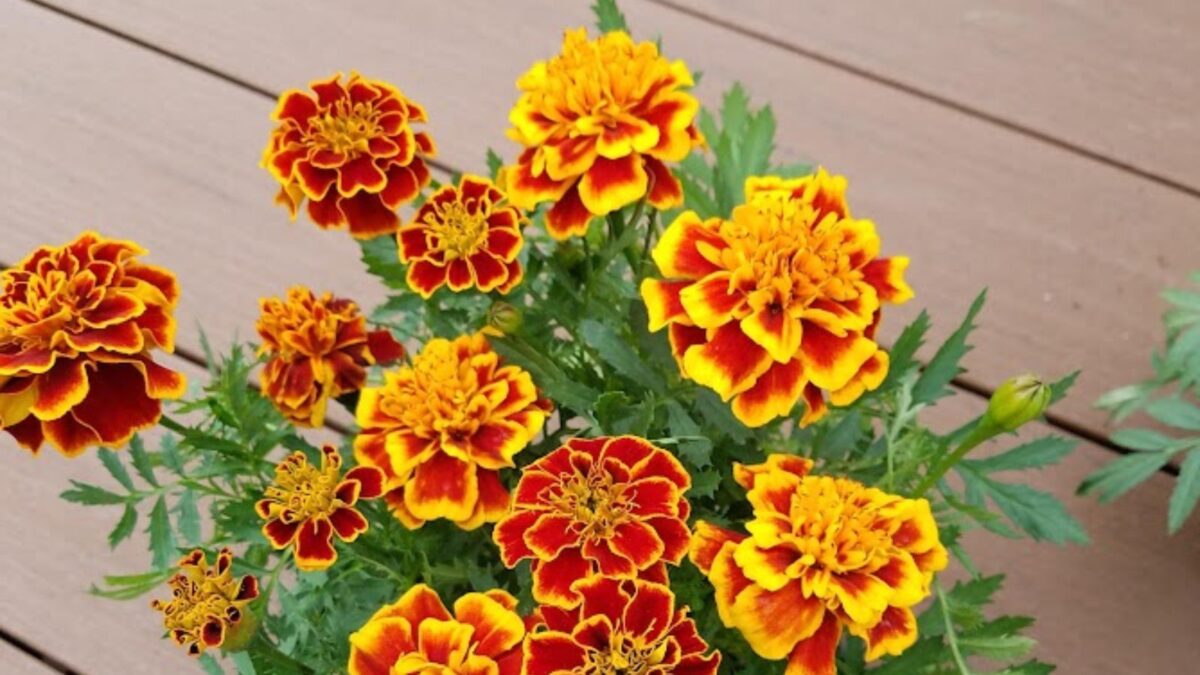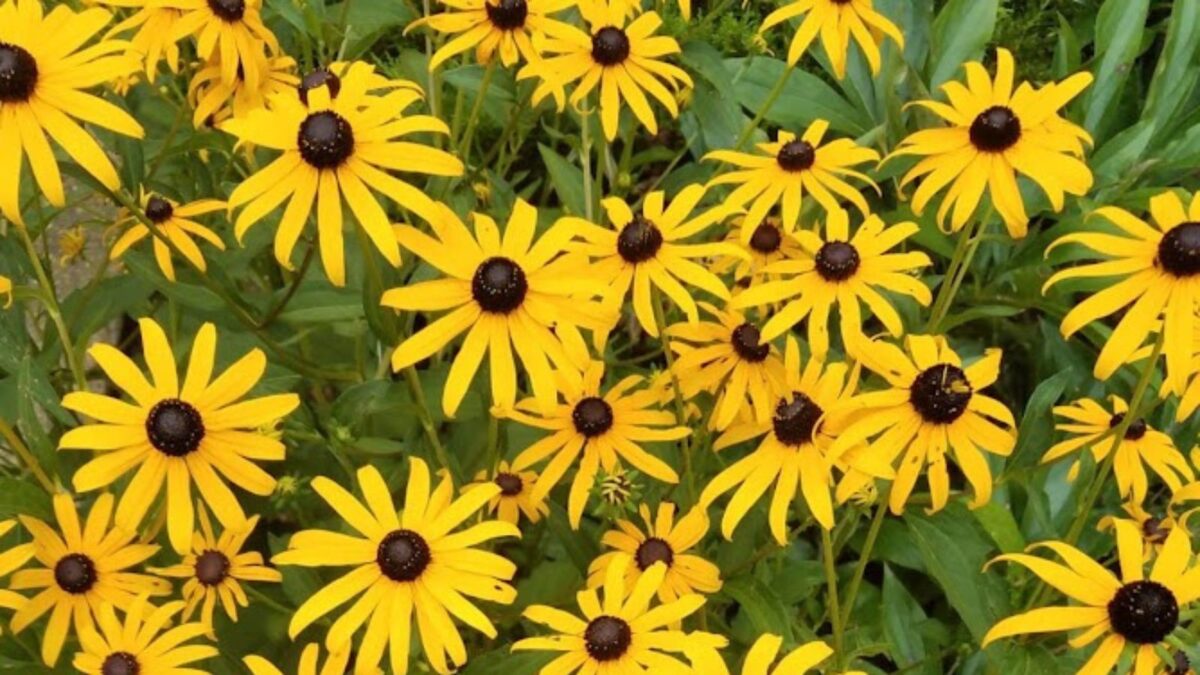Few flowers look more cheerful than a vibrant yellow bloom. Like a little drop of sunshine, such golden blossoms can brighten up a garden with their happy little faces. Though perennials come back year after year, annual yellow flowers are easy to tuck into empty spaces and containers for instant color.

1. California poppies (Eschscholzia californica)

The creamy yellow to bright orange, cup-shaped flowers of California poppies wave on slender stems above feathery, blue-green foliage. They will continue blooming from spring until mid-July, especially if deadheaded, and often self-sow in ideal conditions.
Native to the western United States, California poppies tolerate hot, dry conditions and poor soil. They thrive in full sun in USDA hardiness zones 6-10.
2. Pansies (Viola x wittrockiana)

The popular pansy comes in a wide range of vibrant colors, including shades of yellow. These low-growing but showy flowers bloom happily in fall and spring, and sometimes through mild winters, but die back in the heat of summer. Add them to flower beds, containers, and hanging baskets for lovely pops of color everywhere.
Hardy in zones 6-10, pansies appreciate part to full sun and moist but well-drained soil.
3. Marigolds (Tagetes spp.)

Known for their benefits as companion plants in the vegetable garden, marigolds can add ruffles of golden yellow to flower beds and containers too. Varieties of annual marigolds range from about one to four feet tall and from solid yellow to vivid red and gold bicolor petals. They also have a wonderful spicy floral scent.
Marigolds bloom best in full sun and moist, well-drained soil but will tolerate part sun and drought. They will grow just about anywhere, from zone 2 to 11. Learn more about growing marigolds.
4. Canary creeper (Tropaeolum peregrinum)

A unique member of the nasturtium family, canary creeper has fringed, canary-yellow petals that look something like wings. These tropical flowers bloom throughout the summer and will climb 10 to 12 feet. The deeply lobed, palmate leaves offer an attractive backdrop to the showy blooms.
Canary creeper is grown as a summer annual outside of zones 10-11. It thrives in moist, well-drained soil in full sun.
5. Strawflower (Xerochrysum bracteatum)

Also called everlasting daisy, strawflower blooms from late spring until frost, and the flowers can be preserved even longer by drying. They retain their color and daisy shape remarkably well when dried, and even as fresh cut flowers, they last a long time.
Though a short-lived, tender perennial in zones 8-10, this Australian flower is often grown as an annual in cooler regions. It grows well in part shade to full sun and occasionally dry to moist soil with good drainage.
6. Calendula (Calendula officinalis)

Also called pot marigold, calendula has daisy-like to ruffled, double blooms in shades ranging from bright yellow to burgundy. They grow one to two feet tall and can fade in the summer heat but may rejuvenate in the fall if cut back.
Calendula likes average, well-drained soil in full sun, though it appreciates a bit of afternoon shade in hot summers. It grows in zones 2-11 and may self-sow.
7. Lantana (Lantana camara)

Lantana produces striking clusters of tiny flowers in vivid colors, including golden yellow and bicolor varieties. The blooms attract hummingbirds, butterflies, and other pollinators from midsummer until frost, and the plant averages eight to 12 inches as an annual.
A woody perennial in zones 8-12, lantana is grown as an annual in most of the United States. It thrives in full sun and moist, well-drained soil and tolerates drought and heat.
8. Snapdragon (Antirrhinum majus)

Attractive to all ages, the snapdragon somehow manages to be at once both elegant and whimsical. Its two-lipped, tubular flowers resemble a dragon’s snout and bloom in spiked clusters that attract pollinators and make good cut flowers.
Snapdragons thrive in full sun to part shade and moist, rich, well-drained soil. Though commonly grown as an annual, they may overwinter as a short-lived, tender perennial in zones 7 and warmer.
Learn more about growing snapdragons.
9. Garden mum (Chrysanthemum spp.)

A beautiful late-season flower, the garden mum provides some much-needed vibrancy throughout the fall. Though commonly placed in containers on porches, mums can also be planted in the ground for lovely mounds of color in the waning flower bed. Check out the best companions for mums.
Garden mums thrive in rich, well-drained soil in full sun to part shade and will grow in zones 3-9.
10. Sunflower (Helianthus annuus)

Though often reserved for the vegetable garden, sunflowers should also have a place in flower beds. These large, sunny blooms come in dwarf varieties under two feet tall, towering stalks reaching 10 feet high, and everything in between. Place them in back borders or mass them for a stunning statement, and enjoy watching the birds and bees they attract.
Sunflowers grow in almost every zone, thriving in full sun and well-drained soil.
11. Bidens (Bidens spp.)

The small, golden, daisy-like flowers of bidens bloom above equally lovely ferny foliage all season long. With numerous species, some bidens are native to the United States (B. aristosa and B. laevis), while on the other end of the spectrum, some are invasive, so take care in choosing varieties for your garden.
Bidens appreciate rich, well-drained soil in full sun, and they tolerate heat and drought. Some species are perennial, especially in zones 8 and warmer.
Add a Few Yellow Perennials to Your Garden for Years of Cheerful Blooms

Don’t limit yourself to annual flowers: these yellow perennials will give you years of beautiful blooms without any extra work.
How About Some Show-Stopping Yellow Flowering Shrubs

If you need an anchoring plant and love yellow, try one of these yellow flowering shrubs. They can also create nice edging, and even provide privacy from curious neighbors.


